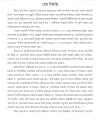Dr Sanjoy Kr. Hazarika
(atskhdrn@gmail.com)
Among the innovations, Numbers are one of the most innovative ideas of humankind. They make our everyday life convenient and straightforward, from measuring ingredients for a recipe to calculating the time it takes to reach a destination. Let us imagine how difficult it would have been to measure, count, access, record and quantify different parameters if numbers were not there. The branch of knowledge that deals with the study of numbers, i.e., Mathematics, is one of the most distinguished disciplines with a "continuum" of applications from "zero to infinite". At times, it "differentiates" between the "chaos" and the "stability"; sometimes, it "integrates" different disciplines of knowledge. It takes us to the "limits" of truth and encompasses the different "dimensions" of expertise. It makes the "complex" things "real" and fascinates us with the notions of "games" and "probability".
One of the most celebrated mathematicians from India is Srinivasa Ramanujan. His genius and contributions to Mathematics are unparalleled, and his work inspires mathematicians worldwide. Today, we commemorate his birthday as National Mathematics Day, a testament to the impact of his work. Ramanujan's life and notebooks are a testament to his dedication and love for Mathematics. He independently solved numerous complex problems and made ground-breaking contributions to number theory, leaving a lasting legacy in the field. Our country has a rich tradition and has made several contributions to mathematics since ancient times. This verse from Vedanga Jyotisha (500 BC) is testimony to the pedestal on which we keep Mathematics. Mathematics, or Ganit, has been a dominant discipline in India since ancient times, and the legacy has continued over generations through Guru-Shishya tradition, books and works.
Shulba Sutras, written in 800-500 BCE, contain concepts of geometrical shapes like squares, rectangles, right triangles, square roots, etc. The Pythagorean triples are also highlights of Shulba Sutras. In 300 BCE, Acharya Pingala illustrated the idea of sunyata or zero for the first time. There is also evidence of zero as a placeholder in the Bakhshali manuscript. In the fifth century AD, Aryabhata gave the basis of the decimal system and calculated the value of Pi to four decimal places. Brahmagupta clearly defined and used zero and mentioned negative numbers in the seventh century AD. His treaties Brāhmasphuṭasiddhānta and the Khandakhadyaka have detailed illustrations about series, geometry, arithmetic and algebra, to name a few. Sridharacharya, in the ninth century, was the pioneer in finding the roots of a quadratic equation. Legendary Bhaskaracharya wrote Siddhanta Shiromani in four volumes: Lilavati, Bijaganita, Grahagaṇita and Goladhyaya. These four volumes have complex mathematical ideas in the form of verses. The works of Bhaskaracharya have theorems and concepts of modern-day calculus, arithmetic, trigonometry, algebra and astronomy.
Recently, mathematicians from India have also solved problems of crucial importance. Ramanujan is the epitome of mathematical excellence; apart from him, mathematicians like CR Rao and CS Seshadri, to name a few, have done immense service to the discipline. Our IITs have also solved critical mathematical problems by developing the AKS (Aggarwal-Kayal-Saxsena) Primality test and Karmarkar's algorithm to illustrate some instances. Prof Manjul Bhargava, who won the Fields medal, equivalent to the Nobel, brought laurels to India through his number theory. The AKS Primality test is a deterministic primality-proving algorithm created and published by Manindra Agarwal, Neeraj Kayal, and Nitin Saxena, computer scientists at the Indian Institute of Technology, Kanpur, on August 6, 2002.
The new National Education Policy (NEP) 2020 has significant provisions and provides a platform to build, nurture, foster, encourage and multiply mathematical thinking. It introduced the reforms needed to balance the need for 21st-century employment and entrepreneurship, which were marked by critical, lateral, and mathematical thinking. The NEP appreciated the necessity of mathematical thinking and its importance in helping the country become a Vishwaguru. Big data analytics, artificial intelligence, machine learning, and blockchains are today's key technologies, and mathematics is the core of all these technologies. Hence, it is critical to build our youngsters' computational thinking capabilities. The NEP provides the necessary nourishment by making Mathematics enjoyable and engaging using innovative methods from the foundational step. NEP also mandates introducing a coding curriculum from middle school as it helps develop computation capabilities and intuitive reasoning.
The applications of Mathematics are extensive and diverse. The NEP allows students to apply their knowledge to mathematics by introducing the multidisciplinary curriculum and credit-based mechanism. The reforms proposed in NEP will be significant to the students, including mathematics. Policy provisions for establishing Mathematics clubs in Higher Education Institutions for better collaboration and interdisciplinary research is an added feature for loving Mathematics. Though NEP focuses on popularising Mathematics, it solely depends on the teachers. Mathematics has become a fear for most students because of the inefficiency of a section of mathematics teachers. So, teachers should revamp their techniques to teach mathematics to make it fun for students. Thus, the very aim of the NEP for Mathematics will be materialised. Source: NEP (2020), The Report and Hindustan Times, December 22, 2020.
(The Author is an Academic Counsellor, IGNOU, DKD College Study Centre and the Director (Hon.) of Proficient Career Counselling, Dergaon)





















0 Comments